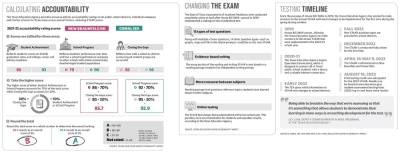The districts also worked toward improving technology resources, increasing their focus on typing skills and responding to open-ended questions. The now entirely online format for the exam was due to a decision from legislators in 2019 to redesign the STAAR test.
The redesigned exam may also lead to changes in how STAAR scores are weighed, which could impact district accountability ratings. The ratings assist administrators in identifying their high-performing campuses and working to replicate their success in other schools, said Krista Moffatt, assistant superintendent of teaching, learning and leadership for CISD.
The new test also features question variation and changes to written essay prompts. It requires knowledge of subjects outside of the one being tested, according to the TEA.
“Being able to broaden the way that we’re assessing so that it is something that allows students to demonstrate their learning in more ways is just an exciting development for the test and exciting to see that in action,” said Lily Laux, deputy commissioner of school programs at the TEA.
Teaching the test
Only 75% of the questions are multiple choice with the remainder made up of the new question types, including short constructive responses and extended constructed responses, according to the TEA.
One of the goals of the redesigned exam is to align better with classroom instruction, which Moffatt said she can see reflected in the cross-curricular test questions.
“There is a lot of deeper thinking during the assessment and questioning, being able to find multiple ways for students to show what they know,” Moffatt said. “This is what happens in the classroom.”
Matt Jones, NBISD’s chief communications and technology officer, said overall, students have adapted well.
“Our students have been taking practice STAAR tests on the app, which has really helped them prepare for the redesigned testing process,” Jones said.
Accommodations were also made for students who needed to take the paper exam or required text-to-speech service, American Sign Language videos or braille devices.
Tackling technology
Laux said the TEA took a multiyear approach to prepare students and educators for the new exam. The TEA conducted a feasibility study and provided grants to school districts in need of technical support to build up their infrastructure.
Funding from the 2021 bond helped CISD strengthen its Wi-Fi connections and purchase more computers for its students districtwide.
Jones said due to the district’s Transforming Every Classroom 21 initiative, which has been in place since 2012 and prioritizes online learning, students have adapted well to online learning and the new STAAR.
“The TEC21 initiative provides our students with constant access to their own personal devices, which empowers them to use technology, regardless of income,” Jones said. “The redesigned STAAR test that was administered online was a seamless transition for our students because we use similar online methods of teaching every day in our classrooms.”
Weighing the scores
Fifteen question types are in the new exam, including open-ended questions, writing at every grade level, graphs and fill-in-the-blank prompts. The grading process has also changed so students can receive partial credit for their answers.
Much like the previous exam, multiple-choice question responses are worth one point. In the new exam, short constructed responses are worth two points, and extended constructed responses are worth up to 10, Moffatt said.
Laux said the grading process has become more streamlined and is meant to get scores back much faster than the previous test.
The state Legislature has removed the requirement that students must perform well on the STAAR to advance to the next grade.
“This is a big deal,” Laux said. “It’s important that we think about it as a tool that gets both families and educators good information. One test should never be all that anyone knows about a child or uses to make decisions about that child.”






